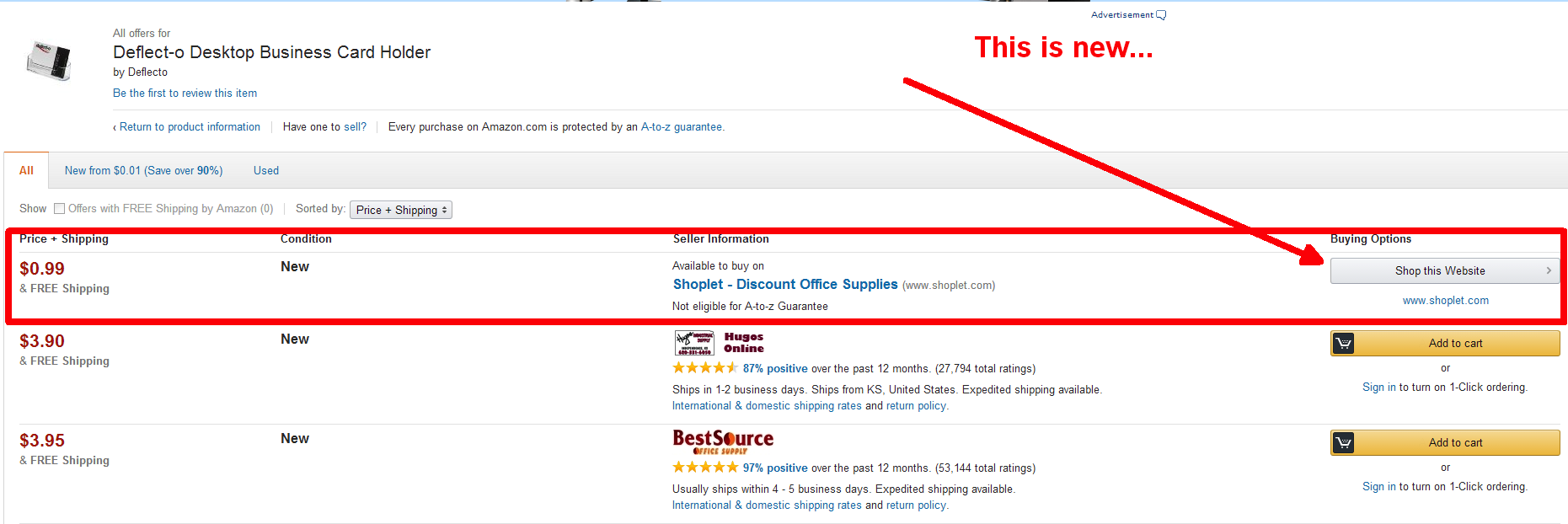
Last week, Amazon began testing a new spot for ads: right on the offer page where you’re fighting other sellers’ offers for the coveted top spot in the list.
These ads appear alongside regular offers, but are different in several very important ways. Keep reading to learn more.
Big Differences
- The Seller Information column includes a direct link to the advertiser’s website. Some sellers may find this unfair, given that regular Amazon sellers are not allowed to include anything that even hints at an external website’s URL in their seller names under risk of account suspension.
- There’s no feedbackA performance rating on a scale of 1 to ... More. This is not like “just launched” sellers, who haven’t received any feedback. Instead the feedback section is simply missing. Given that only Amazon themselves don’t have feedback, there is perhaps a risk that some buyers will interpret this lack of feedback as an endorsement of sorts.
- There is text below the seller name and website stating “Not eligible for A-to-z Guarantee”. This will definitely put off some buyers, if they are aware of the advantages of the guarantee.
- There is no “add to cart button”. Instead, a grey “shop this website” button that takes buyers to the advertiser’s website.
Advantages for Amazon Sellers
There are two great advantages that 3rd-party Amazon sellers will likely have over these ads:
- FBA: External website ads will not show up when the buyer uses the “Offers with FREE Shipping by Amazon” checkbox, and they will not be attractive to Prime program members.
- Buy BoxThis refers to the situation where a sel... More: external website ads will (most likely) not be eligible for the Buy Box, so sellers competing for it directly will simply be able to ignore such offers.
Questions to Consider
- Will websites be able to buy the premium top spot in the offers list regardless of their offer’s price (override the default sorting by landed price)?
- Will there be a single available space on the offers page, or will multiple websites be able to publish their offers alongside regular sellers, potentially capturing the entire first page?
- Will such offers be eligible for the Buy Box?
- How much will these ads cost?
And perhaps the most important question of all:
Will customers opt for these offers, or keep choosing the regular ones?
Time will tell. For now, this program’s viability is still being evaluated, so we’ll have to wait for the official announcement before we can assess its long-term impact.
In the meantime, we’ve reached out to our contacts at Amazon and will update you with new information as we receive it.
What do you think of these ads?
Emin Filip
 Emin Filip follows trends and advances in online selling, looking forthe impact they may have on online merchants, including 3rd-party Amazon sellers.
Emin Filip follows trends and advances in online selling, looking forthe impact they may have on online merchants, including 3rd-party Amazon sellers.
At SellerEngine he is the Product Owner of Sellery, the premier repricing software for Amazon sellers. He makes sure that the needs of Amazon sellers are reflected in SellerEngine’s software.






10 Responses
I am an FBA seller. I went to replenish stock on a shampoo and conditioner bundle listing that I created at a $14.95 price point. I found the only seller there to be Dollar General. Their ad wasn’t off to one side, it was the only choice. I understand this is probably because the item was out of stock FBA. The problem was that their listing was for a $3.00 item. When I clicked through to their website, I found this was only for the shampoo, and not the set. The exact same ad was lower on the page where it suggests other products that might interest a customer. This was for the shampoo only on Amazon, but the click through was to the same shampoo only on DG’s website. Amazon is probably getting paid by the click throughs. I think this new thing cheapens Amazon’s trendy, cool reputation… kinda like seeing a Starbucks in a Walmart.
This could be bad news for sellers who use retail arbitrage to source new inventory. Today, I might buy a $10 item at Walmart and sell it for $25 on Amazon. Tomorrow, Walmart might have an ad for that item and sell it for $10 to Amazon customers too, wiping out the retail arbitrage sellers.
Also, it seems like this could also hurt Profit Bandit, Sellery, SellerEngine, and all other similar apps and programs. These programs see what the Amazon APIs show them, specifically, offers from Amazon sellers. If the lowest offers are around $25, and Walmart puts up an ad for $10, these programs won’t see that. They’ll continue to reprice or display profits based on Amazon sellers’ offers, and not realize that these offers will almost never be purchased because Walmart is offering a dramatically lower price.
Good point about the API. I wonder if (at some point) they’ll tell us if the ASIN has this kind of ad on it?
I’m not sure a lot of sellers will want to compete with these off-site offers, but I bet they’ll want to know about them!
-Paul
We are in contact with the API team and they’re waiting to see if this new program sticks. If it does, then they will surely include the data somehow, soon enough.
Tracy, Nick, your concerns are spot-on. I am hoping that they will be addressed, at least to some extent, once Amazon releases the terms of service for this program as well as the pricing. The terms of service will dictate what such ads can and cannot do – and there will likely be a condition in there related to the accuracy of the ad. The pricing for these ads will dictate to what extent retailers will be able to discount their offers (or how many such offers they can post).
How do you create these listings? It looks like this article is at least a year old based on other comments, but I ran across one of these for the first time today. I’m trying to figure out if there is a place to create these ads or if it’s some sort of invite only thing.
Are these ads part of the productads? Can you please be specific about how these ads are obtained? Which Amazon ad program includes this? Thanks
Greg, Jason, sorry about the late reply.
Last we heard of this, from Amazon, was over a year ago. Back then, they were telling us this is a “pilot” program and they were still trying to see if it’s worth moving forward with. You can’t simply obtain these ads, most likely only merchants hand-picked by the program’s project manager have been given the opportunity to try them out.
Since there has been no official communication from Amazon so far, chances are the data isn’t sufficiently compelling. Perhaps these ads aren’t driving enough traffic to justify their cost?
It seems likely that a person who has gone through the trouble of searching for product on Amazon, and who ends up on the offers page (rather than just buying from the person owning the Buy Box), is quite committed to finding a good offer on Amazon.
How to do that on Amazon please help! (The Seller Information column includes a direct link to the advertiser’s website or our website). We are Pro Seller on Amazon We need your help.
Hi Tuan,
This program is, in fact, not for Amazon sellers, but for 3rd party websites who wish to advertise on Amazon and, specifically, target the offers page.
I suggest contacting the Amazon Product Ads team directly, using this form: http://services.Amazon.com/content/sellers-contact-Amazon.htm/ref=as_us_cu_navt1?ld=AZAdvertLearn1AS
There’s no indication so far that the program has been made public, and we haven’t seen a lot of such ads, so they may have given up on it.
Hope this helps.
The reason you see no rating or A to Z is because these sellers use their own merchant account to process payments and drive the customers straight to their site to purchase. It has nothing to do with Amazon driving customers away.